< Previous | Contents | Next >
The "Ashes" Factory, Wolverhampton.
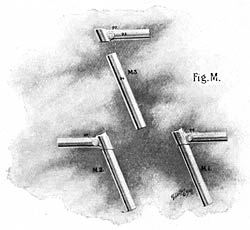
Detachable Seat Pillar.
These works, as previously intimated, were acquired by the Humber Company ten years ago, and since then have been constantly added to, with the result that they are now four times their original size. As the arrangement and mechanical outfit are precisely similar to those at the Beeston works, it is unnecessary to give a detailed description of the work carried out in the various departments. The premises include the Turneries, both the old and new shops, the latter recently erected, being 200 feet in length and 70 feet in breadth. There are in all six large Erection Shops, with a total area of nearly 15,000 square feet ; the Enamelling Department is almost 100 feet long, whilst the Plating Shop is on an equally elaborate scale, both these sections of the works being equipped with the most up-to-date plant. The Finishing Shop is over 100 feet long, and occupies a floor area of 3,000 feet. The Poultney Street Works, comprise also extensive premises, which are efficiently organised to relieve the pressure of demand on the resources of "The Ashes."
The Coventry Works.
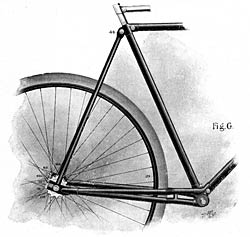
Duplex Chain Stay and Swing Back Stays.
The first check to the successful career of the Company was experienced on the occasion of the calamitous fire, by which their Coventry premises were almost entirely destroyed. With characteristic determination, the firm promptly set about retrieving the disaster, and upon the site of the ruins within a very brief space was reared the handsome and commodious pile of buildings which now provides a centre of operations for the business in the principal seat of the English cycle industry. Meanwhile, the majority of the employees were installed in temporary premises, and new machinery was put down within fourteen days, thus obviating a more than trifling delay in the execution of the numerous orders on hand. The new Factory is four times the size of the old one, and contains in the front portion a suite of elaborately fitted offices, illuminated by an electric light installation. The buildings in the rear are of four storeys elevation, and give a total floor space of over 100,000 square feet, the whole of which is utilised for the purposes of the manufacturing departments. These, in common with those at the Beeston Factory, are located in commodious workshops and are replete with every requisite and convenience for the various operations carried out, the fitting department alone being furnished with over 5,000 feet of benching. The principal section here is similarly the Turnery, an extensive department, containing upwards of 20,000 square feet, and furnished with machinery and tools valued at more than £30,000.
Profiting by recent experience, the Company have erected the new works on fire-proof principles throughout, and in their construction some 400 tons of steel girders have been utilised, and about 5½ miles of steel joists provided to ensure, as far as is humanly possible, immunity from future disaster. The output of this factory is 1,000 machines a week, a total, of course, greatly multiplied by the production of their other works at home and abroad, which give employment to about 7,000 hands, the mechanical and manual facilities at the Company's disposal enabling them to turn out a complete cycle in every forty seconds of a working day.
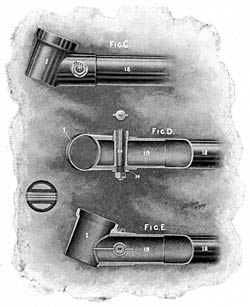
Detachable Joint.
At the Beeston Factory operations are entirely confined to the manufacture of the highest grade cycles; the Wolverhampton establishment to a make of machines which—although excelled by those made at Beeston—are superior to the highest grade cycles turned out by other firms, at prices that compare favourably with those charged by their competitors, whilst at Coventry they turn out a thoroughly up-to-date and high-class cycle, at a price which brings it within the reach of the great majority of riders.
Thanks to the courtesy of the Company, we are enabled to indicate the chief specialities in new designs, and the more prominent improvements in construction embodied in the list of "Humber" cycles for the season of 1898.
Among the new patents therein described are those of the new Detachable Joints, which mark the most important development in cycle construction since the introduction of the pneumatic tyre in 1888. The Company have now adopted the detachable joint as their standard pattern to be fitted to all their Beeston and Wolverhampton Safeties. As its title implies the invention enables the entire framework to be readily taken apart, and then conveniently packed in comparatively small compass, a most important factor when travelling abroad, and it also presents facilities for storing away in winter, The chief advantage is, however, that in case of accident, a new tube can be procured from the works, and fitted almost instantly.
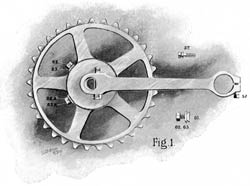
Detachable Crank and Gear Wheel.
Another important feature in the models for 1898, is the Detachable Crank and Gear Wheel, which is fitted to all adult safeties and tandems unless otherwise specified. The chain wheel is threaded and screws on the crank boss, being held secure by bolts, wedges and washers, which readily unlock by a spanner, but are perfectly reliable when tightened up. The boss of the crank is so arranged as to allow of the chain-wheel being lined up 1/24 inch either to the right or left, by which means a perfect alignment of the chain can always be attained. Equally efficient in action, as they are original in construction, are the Adjustable Cranks, fitted to all Beeston and Wolverhampton machines, and recently designed by the firm to meet the demand for cranks enabling a rider to easily obtain the exact throw best suited to his requirements. This object has been attained in the new cranks without widening the tread in the least. In the Reversible Saddle Pillar is embodied a much desired aid to seat adjustments which is fitted to the Beeston and Wolverhampton machines. By means of this Patent every desirable attitude can readily be attained, and as very few riders assume exactly the same position, the advantage of this simple pillar is obvious.
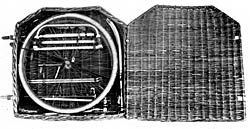
Complete Machine, with Brake and Mudguards taken apart by means of the Detachable Joints.
Other improvements patented and introduced in the Humber cycles, include a Swing Chain Adjustment, which has been used on these machines since 1892, and is now fitted on all safeties and tandems; the Crank Bracket Adjustment; the Duplex Chain Stay introduced in 1897; and minor details of construction tending to the perfection of the various models.
Among the specialities of manufacture which will inevitably attract attention in the coming season, distinct and merited prominence must be assigned to the Aluminium Specially Light Road Racers, numbered 9 and 10 on the list. These machines are an unique and important departure from anything previously brought before the public. By the use of the new patent detachable joints, previously described, the apparently insurmountable difficulties hitherto experienced in successfully constructing a frame of aluminium have been overcome. The framework is built almost entirely from tubes of aluminium, and the saving thereby effected, without reducing the strength in the least, enables the firm to place within the reach of riders machines at a weight previously impossible, whilst a thorough test of their merits under all conditions gives them every confidence in recommending them to experienced cyclists.
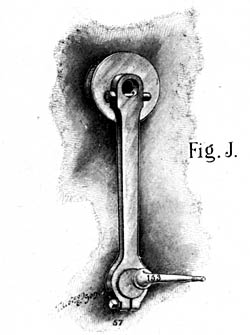
Crank and Pedal Axle, with Eccentric Adjustment.
Next, perhaps, in order of importance are the Ladies' Safeties, Nos. 19 and 20, the success of which has been so marked that the Company now make no other design. The curved upper tube materially strengthens the frame, and provides the maximum space so necessary for mounting and dismounting, and is such as to ensure a most graceful and elegant position. The popularity of this machine may be best indicated by the fact that it is a favourite mount of T.R.H. Princess Louise, Duchess of York, Princess Victoria, Charles and Patricia of Connaught, Grand Duchesses of Oldenburg and Mecklenburg-Schweiren, the Duchesses of Bedford, Marlborough, Portland, Manchester, Sutherland, etc.
The Roadster Safeties share equal favouritism with the machines already described, as attested by the fact that they claim as their riders such distinguished notabilities as their Majesties the Kings of Belgium, Italy, and Greece; T.R.H. the Crown Princes of Belgium, Italy, and Greece, the Dukes of Portland, Fife, etc.; while the Special Light Roadsters or Road Racers are patronised by T.R.H. the Dukes of Connaught and York, Princes Charles of Denmark and Henry of Prussia, the Grand Duke of Oldenburg, etc.
Another entirely new and original design, which is sure to be much en evidence this season, is the Combination Tandem Safety, No. 17 (Beeston make), for lady and gentleman or two gentlemen. The novel improvement in this machine is the extreme rigidity ensured by the use of direct tubes, running from the head to the rear hub and rear bottom bracket, which, coupled with the ease of mounting and dismounting, not only for the lady behind, but also for the gentleman on the front seat, will at once commend itself to every expert and experienced cyclist.
Did the exigencies of space limits permit, we could extend the list of influential patrons of the Humber machines to pages of this work, and it will therefore suffice to add, in conclusion, that among the firm's clientele are numbered, besides the names already given, those of H.R.H. the Prince of Wales, and members of our own and the leading European Courts.
The managing director of Humber and Co., Limited, and Humber and Co. Extension, Limited, is Mr. M. D. Rucker, who has been well known to both the cycling and social world for many years. In his younger days he attained celebrity as an athlete of the first class, especially as a cyclist, and later obtained prominence in the manufacture of cycles, and, upon the retirement of Mr. Thomas Humber some years ago, he became managing director of the Company.
The general manager both of the Beeston and Wolverhampton works is Mr. H. Belcher, who is also very well known in cycling circles. He joined the firm at the age of 22, and four years later was appointed manager of the Wolverhampton works, and after another three years he took over the general management of both works.
